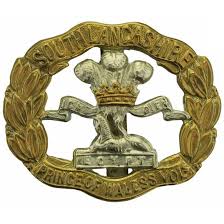Personal Details
Born: 23 September 1869 and baptised 12 November 1869 at St Alkmund’s Church, Whitchurch. His surname has also been spelt Challoner and Challinor on the various records.
Family: Third of ten children born to Jonathan and Elizabeth Challoner. In 1895 he married Lucy Aaron in Ellesmere and they had three children, Ciceley, Lucy and Jonathan.
Residence: At the time of his baptism the family’s address was Virgin’s Inn which was situated at the north end of Chester Road, Whitchurch. John is recorded living with them in the census returns of 1871 and 1881 but is missing from the 1891 census. Ten years later he was back in Whitchurch with a wife and children residing in Wrexham Road, Whitchurch, Shropshire. In 1919 he returned to Ivy Cottage, Grindley Brook, Whitchurch. By 1939 he was widowed and living in Hawkesmoor, Wem, Shropshire.
Employment: Prior to WW1 Jonathan worked as a farm waggoner. In 1939 he was a retired farm bailiff.
Died: Possibly the Jonathan Challinor who died in Bucklow, Cheshire in 1955 aged 85.
Military Details
Regiment: South Lancashire Regiment (previously King’s Shropshire Light Infantry)
Rank: Private
Service Number: 44606 (previously 17072)
Date of Enlistment: Not known
Date of Discharge: Not known
Reason for Discharge: Not known
Other Information: Brother of Randle Challenor who also served in WW1.
Jonathan was awarded the Campaign Medals (British War Medal and Victory Medal).

The British War Medal (also known as 'Squeak') was a silver or bronze medal awarded to officers and men of the British and Imperial Forces who either entered a theatre of war or entered service overseas between 5th August 1914 and 11th November 1918 inclusive. This was later extended to services in Russia, Siberia and some other areas in 1919 and 1920. Approximately 6.5 million British War Medals were issued. Approximately 6.4 million of these were the silver versions of this medal. Around 110,000 of a bronze version were issued mainly to Chinese, Maltese and Indian Labour Corps. The front (obv or obverse) of the medal depicts the head of George V. The recipient's service number, rank, name and unit was impressed on the rim.
The Allied Victory Medal (also known as 'Wilfred') was issued by each of the allies. It was decided that each of the allies should each issue their own bronze victory medal with a similar design, similar equivalent wording and identical ribbon. The British medal was designed by W. McMillan. The front depicts a winged classical figure representing victory. Approximately 5.7 million victory medals were issued. Interestingly, eligibility for this medal was more restrictive and not everyone who received the British War Medal ('Squeak') also received the Victory Medal ('Wilfred'). However, in general, all recipients of 'Wilfred' also received 'Squeak' and all recipients of The 1914 Star or The 1914/1915 Star (also known as 'Pip') also received both 'Squeak' and 'Wilfred'. The recipient's service number, rank, name and unit was impressed on the rim.

